As marketers, we like to believe we are consumer-centric or even human-centric in everything we do, but the reality is that we often get lost in processes, tools, and procedures that are more internally focused on who we are as an organization, what we are doing, and what we want to do rather than externally focused on who our consumer really is, what the consumer is doing, and what they want. In short, we often get so busy managing our brands and our business, that we lose sight of why we are doing it in the first place.
Looking Beyond Category Consumption
And then, even if we are in fact focusing on the consumer, it is often only within the confines of how and when they buy and use our product. Targeting your consumers based on category consumption is limiting for two important reasons:
1. Lacking the breadth and scope of how they live their lives, you lack the understanding of the larger role of the emotional benefits of your brand and will become overly focused on the functional benefits.
2. Category definitions are in themselves limiting. Many major product breakthroughs occur because the company thought outside the self-limiting box of typical users and usage occasions.
Look at what Jeep Cherokee did to Minivans when it created the new ‘SUV’ category or Red Bull did to the soft drink companies in creating the category of ‘energy drinks’. The latter example is especially interesting because literally hundreds of me-too products tried to replicate Red Bull’s global success with a focus on their own self-limiting perceptions about the newly defined energy drinks category. It took ten years until 5-Hour Energy came along, and broke all those category limitations with completely new packaging, usage occasions, and most of all, millions of new consumers! The Coca-Cola Company fell into the same self-limiting trap two times in a row and wonders to this day why their brand Burn never really took off. Their frustrated bottlers didn’t do much better when they went outside the parent company to distribute Monster globally which is just a larger-sized Red Bull with creepy graphics.
Human-Centric Marketing: Customers are Human Beings Too
So maybe it’s time to step back and think about how we structure and build our marketing plans so that they become more human-centric from start to finish. We still utilize the big three of marketing planning – targeting, brand strategy, and communications, but we must build our processes for all three based on a much stronger understanding of who our consumers really are – living, breathing human beings with full and complicated lives.

Unless we start with a comprehensive understanding of who our consumers are and how they live their lives, it will be very difficult, if not impossible, to meaningfully connect to those consumers with your brand on both a functional and emotional level. Connecting to them on a purely functional level is easy, but building a much more powerful and lasting emotional connection requires that you get to know who they are in a broader context relative to how they live their lives, and deeper relative to what they really care about.
When it comes time to seek these consumers with effective brand communications, unless you have this broader and deeper understanding of who they are, you are going to find yourself interrupting what they are doing at that moment of contact rather than a more engaging approach of determining the right time and place when they are open to your brand and product category so that you can create positive purchase intent.
How Well Do You Really Know Your Consumer?
Naturally, if you are going to practice human-centric marketing, you need to start getting a deeper and broader understanding of who they really are as people, not just how they buy and use your category.

There are many types of segmentation methodologies available. Most are limiting either in helping you understand how you can position your brand within their lives so that you can add value, or lack the necessary information to reach them with the appropriate medium and deliver a meaningful message. Look at your segmentation, or any segmentation model you may be considering, and ask yourself if it can truly deliver all the information you need to do your marketing job in the 21st century. An effective segmentation will offer the following useful information to build an effective brand and communication strategy.
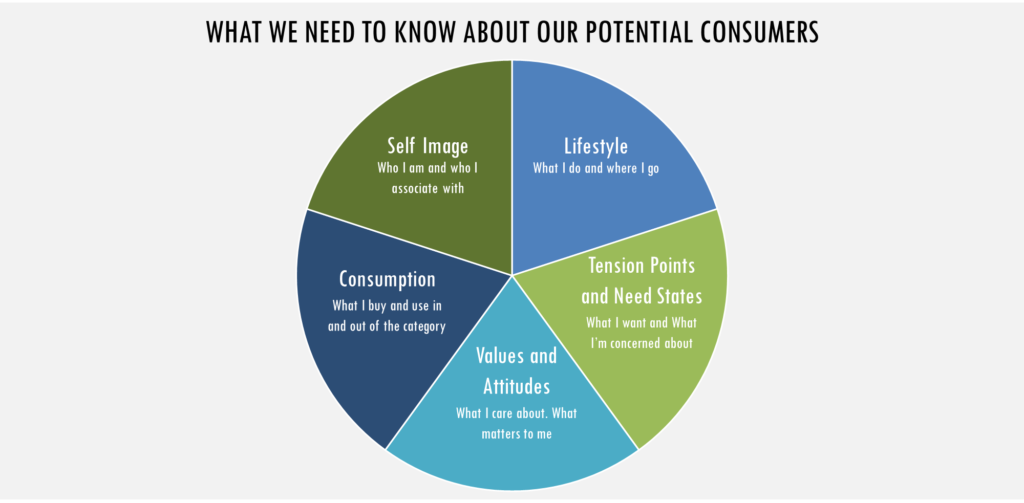
People buy brands because they are aligned with their self-image in some way. Their lifestyle reflects what they do so that you can determine if, when, and where your brand has a role. In later stages, it will also help you to better determine their mindset as they move through their world so that you can more effectively and efficiently reach them through various mediums when they are the most receptive to engage in the message about your brand – and then buy it!
Shared Beliefs
Highly impactful brands such as Apple and Nike go far beyond features and benefits to drive more motivating value for their consumers. They are built on pillars of shared beliefs (achieving my personal best for Nike and individuality for Apple). Unless you understand the values and attitudes of your consumers you cannot possibly compete on the basis of shared beliefs and you have consequently significantly limited the future impact of your brand.
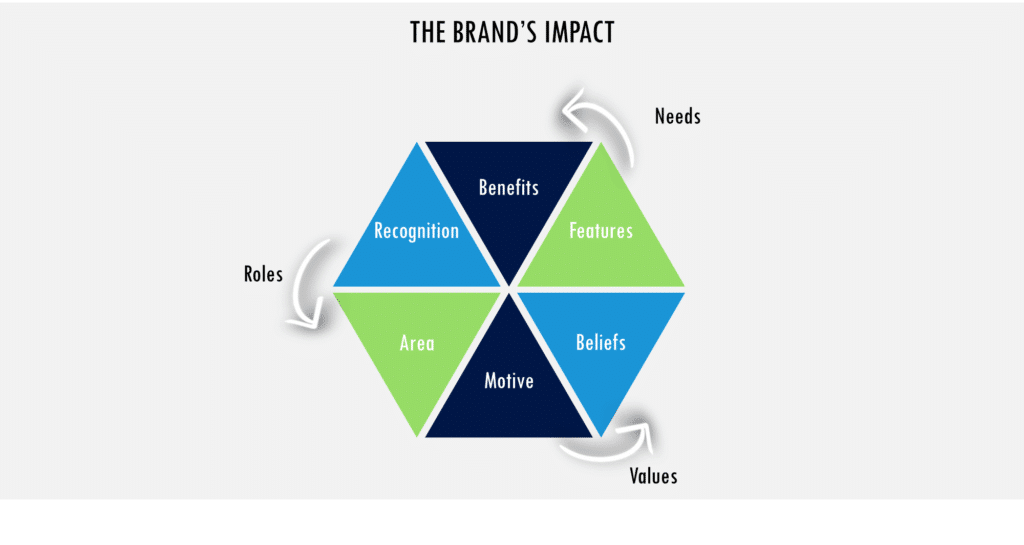
Clustering consumption patterns across a broader range of product categories and brands will illuminate your potential consumer’s self-image, lifestyle, as well as their values and attitudes (beliefs). If your segmentation doesn’t offer insights into those holistic areas (who they are as human beings), you can potentially back into it based on research and analysis of consumption across a definitive range of product categories. By definitive, I mean looking at product categories that help define who people are and the values they hold dear. The choice of an automobile, clothing brand, beverage, toothpaste, and even hair care product consumption speaks volumes about who the consumer is both in terms of lifestyle, self-image, and values and attitudes. In essence, brands are identifying badges that reflect who we are. Utilizing a human-centric marketing approach allows you to make the lack of consumer relevance your competitor’s problem.
The Elephant in the Room
The power to drive new growth for your brand is often hiding in plain sight, but you just don’t know where to look for it. Understanding need states often reflects the value consumers derive from your category. Understanding tension points enables your brand to go beyond need state fulfillment to release deeper emotions. I’ll buy a family car because it reflects my lifestyle needs as a father. I’ll buy a Volvo because it helps me feel like I am being the best parent I can possibly be by putting the health and wellbeing of my children first and foremost. Being a father is a need state. Ensuring I am the best father I can possibly be, reflects a tension point based on my values and attitudes. The Volvo brand represents a shared belief and thereby helps release a significant tension point in their consumers’ lives.
A Human-Centric Brand Architecture

Even if the brand architecture model you are currently using does attempt to look at the brand and its benefits from a consumer’s perspective, it seldom aligns the architecture according to the motivations of the consumer as holistic human beings.
The Motivational Hierarchy
The main advantage of a Motivational Hierarchy model is that it aligns the functional and emotional benefits of the brand based on how motivating those benefits are in driving actual purchase behavior and brand preference. You will also notice that in the Motivational Hierarchy model, the brand benefits are further aligned into three brand distinct pillars that link core attributes of the brand within that pillar as they increase in motivational power for the consumer. It’s not just what you put in each pillar, but importantly how the benefit pillars link these attributes and benefits as they extend from Cost of Entry to Differentiation, and finally culminating into a single brand experience that combines all three pillars – the Crucial Emotional Experience.
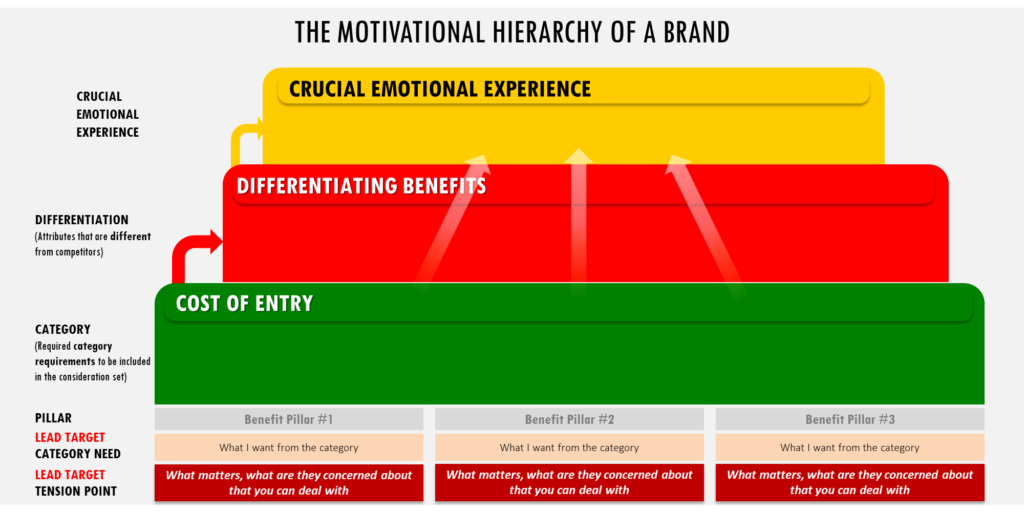
Begin building each brand pillar in your Motivational Hierarchy with the Cost of Entry benefit that relates to a specific need of your targeted consumer-like socializing or good with food which is important for most beverages. Now, look at your tension point for your consumer that specifically relates to how and why that need is particularly important to a targeted human-centric consumer segment. That tension point will propel your brand differentiation benefit about socializing to something more powerful and unique and yet connected to the basic need. Your point of differentiation for each brand pillar should help to release that tension within the consumer – that’s how you create brand preference.
Coordinating those inter-related brand pillars with their need states and tension points into a Crucial Experience with consumers is what your creative team wants above all else in your creative brief because they know not only what to communicate, but why it is important to the target that their communications must engage.
Delivering the Right Message at the Right Time and Place
Most brand communications you see are based on an old-school interruption model. The primary objective of this outdated model was to locate the greatest number of consumers at a particular time and place and then interrupt whatever they are doing with your brand message. You don’t like it when it happens to you, so why do so many of us do it with our own brand communications? Consumers don’t hate advertising – they just hate being interrupted with an irrelevant message.
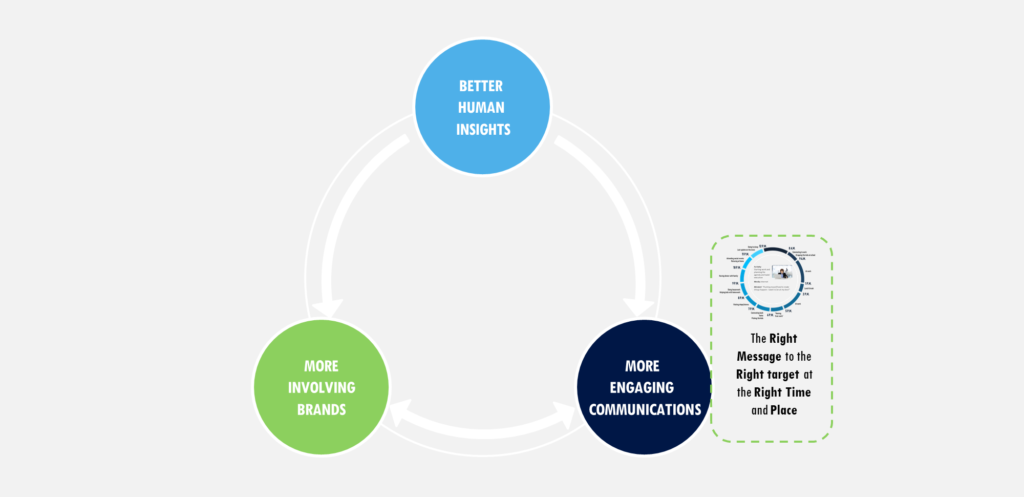
The first step is to use the broader lifestyle and values and attitudes knowledge you have about your consumers to map how they move in their daily lives, how they act within the selling environment to identify potential touchpoints to create purchase intent and drive actual purchase behavior. You can also identify relevant and meaningful touchpoints you have after the purchase to build brand advocacy. Good marketers are not just satisfied with a repeat purchase but aim to convert existing consumers into brand ambassadors who help sell other consumers because they love the brand experience you provide.
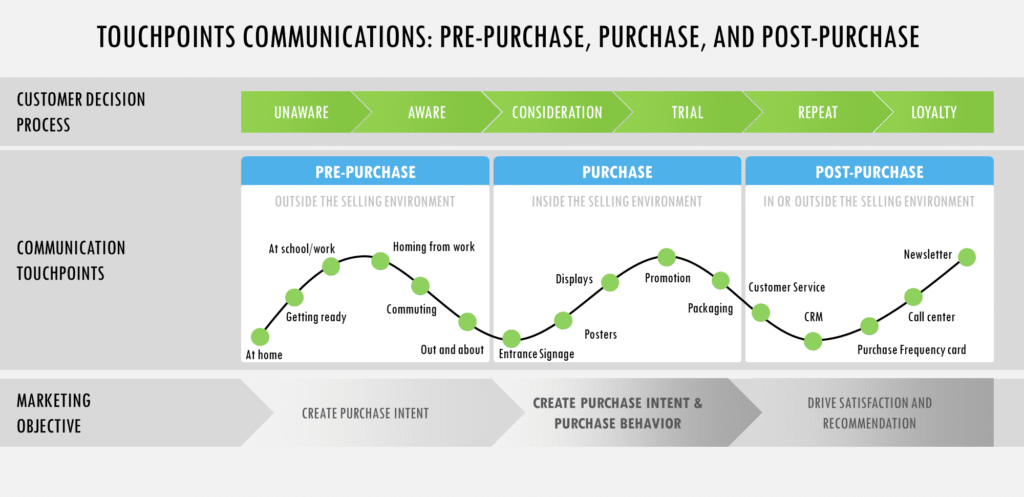
Moving From Interruption-Based Communications to Engagement-Based Communications
The challenge you face moving from interruption-based communications to engagement-based communications is understanding the relevant and appropriate role your brand can play within the consumer’s lives.
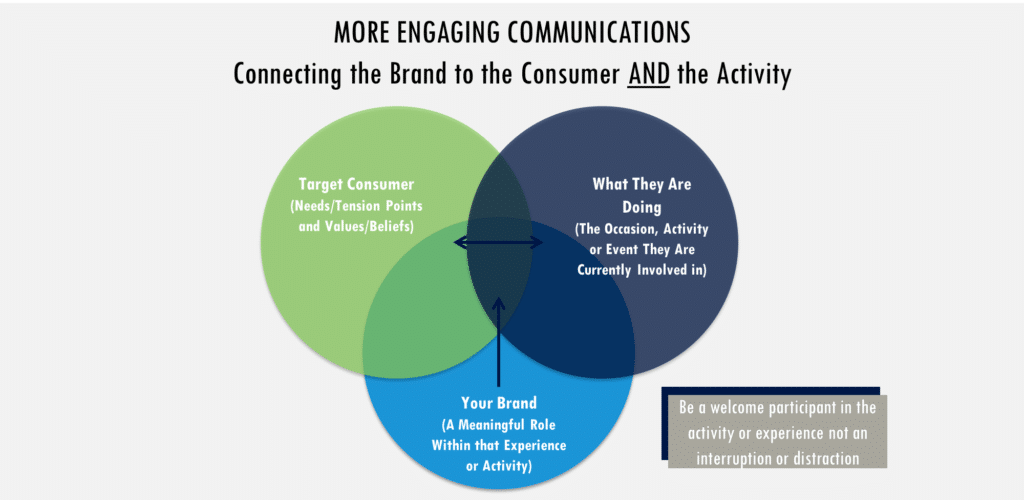
By understanding the consumer and how they are involved in a particular activity, you gain the ability to craft your brand message to be a welcome addition to that activity. Most activities and times of the day simply will not fit your brand no matter what you do creatively – like trying to sell beer in a commercial during the morning news. And even when you do nail down those few occasions in their daily lives that the message could be welcomed, it doesn’t mean they are anxiously waiting for it. They almost never are. However, identifying the appropriate times when their minds and their attitudes could be open to your product category are the specific touchpoints where you direct your creative team to engage.
An example is that parents of young children tend to be in a reflective mode in an hour or two after they put their children to bed and consequently could be more open to messages about their future plans such as insurance needs, or in the case of a furniture brand, how to re-decorate or re-model some part of their home. You get the idea. The creative team still needs to craft a message so that the consumer will let you into their activity, but now you can provide the creative people working on your brand not only with deeper insights about your consumer target’s potential relationship with your brand but the precise times of day and what your target is doing, thinking and feeling in that moment. There is a lot of engagement potential in that knowledge.
Media First, Creative Second
To execute this consumer-centric communication strategy you need to reverse the relationship order between media selection and creative development. In the old days, you would develop the creative (typically starting with a TV commercial) and then look for appropriate mediums to reach large quantities of potential consumers efficiently – that’s why TV was so prevalent in that process. TV commercials can still be important in your media mix, but they probably shouldn’t be the starting point. It depends on the consumer and how you develop and nurture the relationship you have across a much more selective and complicated range of activities and mediums.
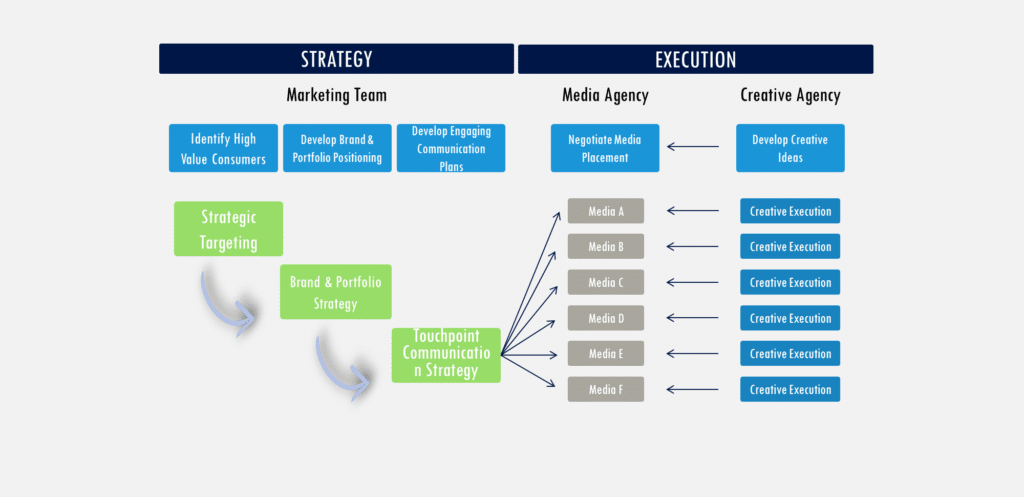
Human-Centric Marketing that Drives Exponential Results
Spread a human-centric logic across your entire business system. None of the marketing models illustrated here are incredibly complex. In fact, they are relatively simple and most of all, they’re logical once you start to look at the consumer holistically as you tend to do with all the other people that are important in your life. You have actually been doing human-centric marketing with your parents starting when you were about four years old and now your kids are doing it with you. All of your employees have that same capability that you can unleash to drive consumer value. Empower your organization into a commitment that everything you say and do with your brand – from product development to sales and everything in between – should be based on creating, delivering, and communicating consumer value based on a shared understanding of who your consumer is as a human being.
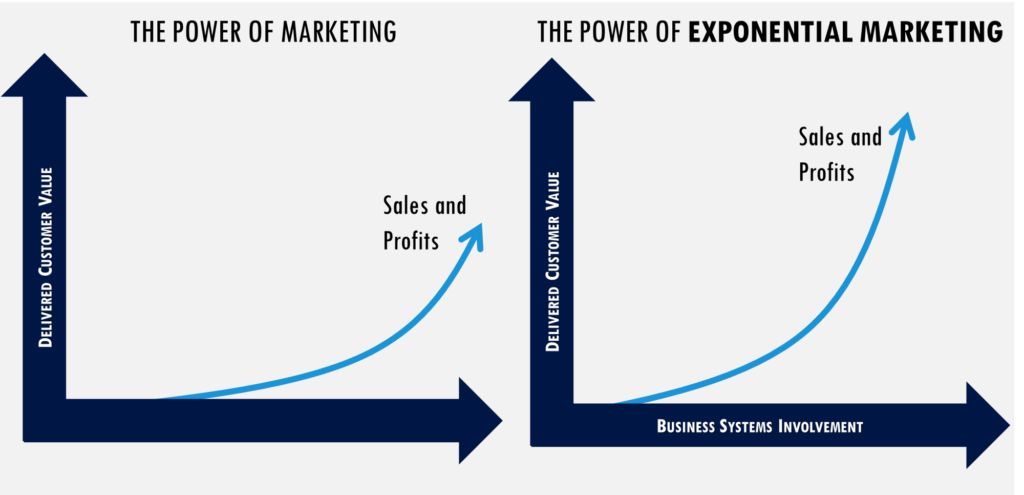
The logic of planning and executing your go-to-market strategy with the holistic understanding of your consumer as the guiding principle is like a compass that will always direct you to a better place – a more powerful and sustained connection with your brand. Not only will your marketing be more effective when you embed this human-centric logic in everything you do, but you will also discover that you can do it much more efficiently. As David Packard, the co-founder of Hewlett Packard famously said; “Marketing is too important to be left just to the marketing department”. A dedicated human-centric approach practiced by as many people as possible across your business system is not only good marketing, it is also good business.



